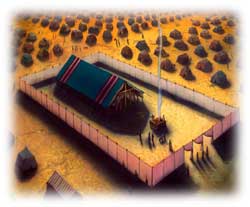

 |
|||||||||||||||||||||||||||
 |
|||||||||||||||||||||||||||
 |
The
Gospel in the Old Testament 
When the people of Israel camped at the foot of Mount Sinai, God instructed Moses to build a portable tabernacle as a sanctuary of worship “according to the pattern shown you on the mountain” (Exodus 25:40). Nearly 500 years later, King Solomon’s great stone temple replaced the portable one. But it was built on the same plan as the portable sanctuary. God gave detailed instructions on the earthly sanctuary’s design and carefully explained how its services were to be carried out. Those Old Testament ceremonies taught the Hebrews through object lessons what the New Testament proclaims as realities through Christ’s life and death and through Christ’s ministry as our High Priest. When God gave Moses the directions for building the sanctuary, what specific purpose did He have in mind?
Sin caused a tragic separation between human beings and their Creator. The sanctuary was God’s way of showing how He can again live among us. It illustrates His plan of salvation . The sanctuary, and later the temple, became the center of religious life and worship in Old Testament times. Its ceremonies reveal how God communicates with us and how we can communicate with Him. Each morning and evening the people could gather around the sanctuary and establish contact with God in prayer (Luke 1:10), claiming the promise: “I will meet with you” (Exodus 30:6). It may surprise you that the Old Testament teaches the same gospel of salvation as does the New Testament. The Old Testament symbolism of Israel’s sanctuary actually depicts the activity of Jesus as Priest ministering on our behalf in the heavenly sanctuary. Rightly understood, the sanctuary and its services reveal what Jesus is doing now in the temple in heaven, and what He is doing now on earth to enrich and guide each of us in our daily lives. |